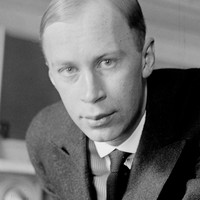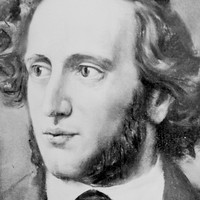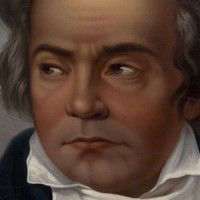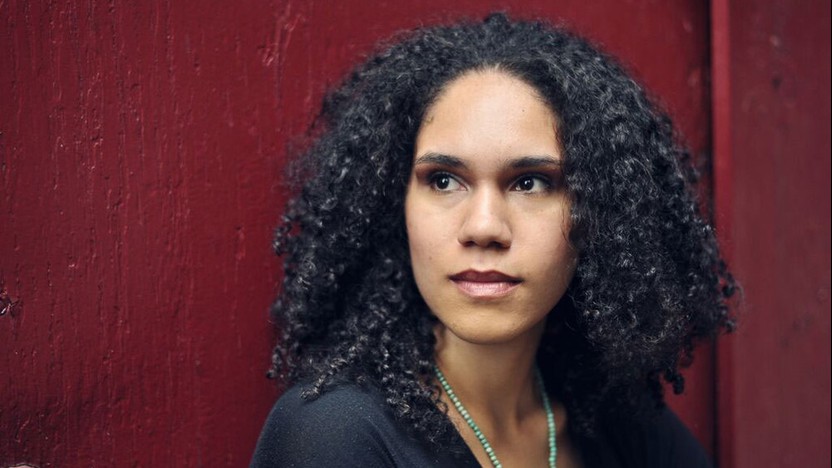Details
 Listen to Audio
Listen to Audio
Sergei Prokofiev
Symphony No. 1, Classical (15 min)
The external trappings of Prokofiev’s Symphony No. 1—its compact four-movement structure, friendly D-major tonality, and, of course, the Classical moniker—amount to something of a Trojan horse. An example of the composer’s Neoclassical style, the Classical Symphony is in fact a work of biting modernism, rife with Prokofiev’s characteristically devilish wit. (The Classical subtitle was Prokofiev’s idea: a bit of fun, perhaps, echoed years later by Britten’s harmonically restless Sonata “in C” for cello and piano.) “I thought that if Haydn were alive today,” Prokofiev remarked, “he would compose just as he did before, but at the same time would include something new in his manner of composition. I wanted to compose such a symphony: a symphony in the Classical style.” Prokofiev’s orchestration (double winds, no low brass) is perfectly Haydn-and-Mozart-sized. As per the Classical style, the opening Allegro and concluding Molto vivace are tightly wrought sonata-form movements. The third movement, a gavotte, even harkens back to the Baroque. Yet the Classical Symphony’s lasting impression is indeed of something unmistakably new.
Though based in traditional tonality, the music’s tonal center is a constantly moving target. The D major starting pistol fired at the top of the Allegro is heard again in the eleventh measure, in C major (close in proximity, but harmonically quite remote from D). The opening melody of the Gavotte wends its way from D major to G major in short order—then takes an even stranger route, via C-sharp major, back to the home key.
Consider, too, Prokofiev’s melodic contours: triadically based, as per the tradition of Haydn and Mozart, but with a sly wink nevertheless. The Allegro’s second theme, uttered con eleganza by the first violins, is decorated with cheeky two-octave grace note leaps. The Larghetto’s featherweight opening melody, set against gossamer string textures, seems at first to nod to the sublime slow movements of Mozart’s piano concerti—yet as it unfurls, the long-breathed tune seems giddily erratic, dawdling like a carefree youth flouting a missed curfew.
Packaged in a symphony of Haydn-esque proportions, the mischievous strokes that give the Classical its spice are made all the more startling. The wolf comes in sheep’s clothing, its bite made fiercer as a result. A century later, among audiences who continue to disdain the early twentieth century’s most audacious scores, the seemingly harmless Classical remains a perennial favorite. Prokofiev’s subterfuge is complete.
Patrick Castillo ©2014

Felix Mendelssohn
Violin Concerto in E Minor
Felix Mendelssohn was a teenager when he met Ferdinand David, a virtuoso violinist one year his junior. Later, when Mendelssohn became music director of the Leipzig Gewandhaus Orchestra, he invited David to join the orchestra as concertmaster. In 1838 Mendelssohn suggested to David, “I’d like to write a violin concerto for you next winter; one in E minor sticks in my head, the beginning of which will not leave me in peace.” The piece gestated for six years, until Mendelssohn fleshed it out in the summer of 1844. While writing the work, he corresponded frequently with David about violin technique, even asking for further advice after sending the score off to be published. David debuted the concerto in 1845, accompanied by the Leipzig Gewandhaus Orchestra. Mendelssohn died two years later following a series of strokes, leaving the Violin Concerto as his last completed orchestral work.
Mendelssohn’s Violin Concerto is full of innovations in form and texture, but perhaps its most radical quality comes from what it lacks: gratuitous showmanship. While the violin protagonist certainly encounters technical challenges and brilliant passages, every gesture is at the service of a shared musical discourse with the orchestra. Some of the most magical moments are those that defy conventional responsibilities, as when the violin launches immediately into the brooding first theme, or when it leaves that same melody to the orchestra after the cadenza, instead countering with ghostly arpeggios.
A single held bassoon note links the first movement to the second, blooming into a heartbreaking “song without words” crooned by the violin. As the slow movement recedes, a dramatic transition provides a link to the finale, with the home key recast as a sunny E major. The buoyant material affords ample opportunities for glitzy passagework, while a regal contrasting theme introduces a note of grandeur. It is fitting that this last major theme reworks the rhythms and intervals of the violin’s initial melody: What first appeared in the concerto as a lonely, searing question returns transformed into a knowing answer, expounded together in a mood of communal cheer.
Aaron Grad ©2014
 Listen to Audio
Listen to Audio
Ludwig van Beethoven
Symphony No. 2
(Duration: 34 min)
With his First Symphony, composed in 1800, the ambitious young Ludwig van Beethoven proved that he could rival his onetime teacher, Franz Joseph Haydn, in his signature genre. Two years later, Beethoven went a step farther, using Haydn’s template as a platform for a Second Symphony that was even bolder and more extreme. The backdrop for this pivotal symphony was a terrible change that was overtaking Beethoven in 1802, when his hearing loss progressed to the point that he could no longer hide it. He finished Symphony No. 2 while convalescing in Heiligenstadt, outside of Vienna, where he suffered in a nearly suicidal state of agony, as we know from an unsent letter to his brothers, found among his papers after his death.
Borrowing a feature found in most of Haydn’s iconic London symphonies, Beethoven’s Second Symphony begins with a meaty introduction full of shifting rhythms, moody harmonies and jarring accents. The fast body of the first movement enters, conversely, with just a wisp of melody in the lower strings. Whereas Haydn loved the elegant dichotomy of forte and piano intensities, Beethoven’s score heightens the contrast, calling for even louder fortissimo and even softer pianissimo dynamics.
The Larghetto slow movement contrasts the adventurous opening movement with music that is serene, tuneful and unabashedly beautiful. The melodic phrases introduced by the violins and answered by the clarinets stay within the sweet treble range of female singers, emphasizing the modest, songlike quality of the material.
The third movement brings Beethoven’s inaugural symphonic scherzo (Italian for “joke”), his raucous answer to Haydn’s genial minuets. The running joke here is an echoing pattern in which the last repetition is shockingly robust.
In the finale, a somewhat rough and rude main theme provides much of the comedic fodder. Beethoven’s craftiness is especially evident in the playful ways he works back to that snarling motive.
Aaron Grad ©2023
About This Program
Led by SPCO musicians and featuring symphonies by Prokofiev and Beethoven, this unconducted program showcases the orchestra's talent, versatility, and teamwork.
This concert is part of our complete Beethoven symphony cycle.

